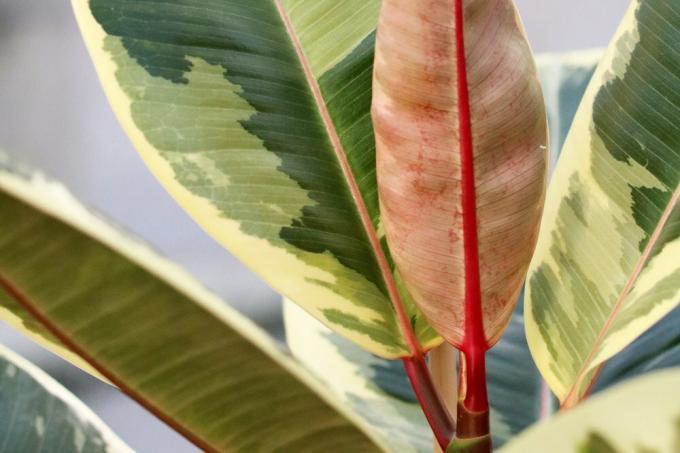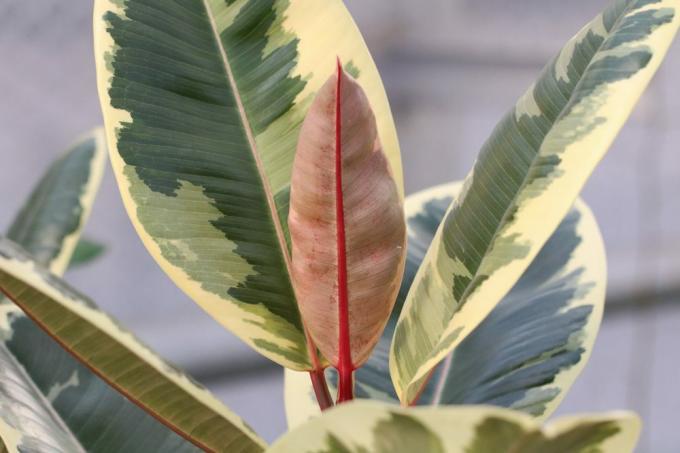
table of contents
- useful information
- care
- Location
- Substrate
- to water
- Fertilize
- Leaf care
- Multiplication
- Illnesses
- sorts
Profile and care information open +conclude -
- Location
- Bad, sunny
- Growth habit
- upright
- height
- up to 5 m
- Soil type
- sandy
- Soil moisture
- moderately moist, fresh
- PH value
- neutral
- Limescale tolerance
- Calcium tolerant
- humus
- rich in humus
- Poisonous
- Yes
- Plant families
- Mulberry Family, Moraceae
- Plant species
- Ornamental plants, container plants, house plants
- Garden style
- Pot garden, winter garden
Until the 1970s, the rubber tree was a common ornamental plant in German living rooms. It also looks wonderful as a container plant in stairwells or office buildings. The Ficus elastica, its botanical name, is equipped with large, rubbery, dark green and shiny leaves. The tropical ornamental tree is a very robust and easy-to-care-for plant that you can enjoy for a long time.
useful information
Fertile seeds only arise from the small, inedible fruit when it is pollinated by the fig wasp.
- evergreen, glossy, thick and rubbery leaves, stalked and ovate
- the bark of the irregularly shaped trunk is light to medium brown and smooth
- Propagation by cuttings or sowing
The rubber tree loves it warm and sunny, because it is a plant that is native to the tropical climate. The Ficus elastica belongs to the genus of fig trees, of which there are over 1,000 species.
It is a popular plant for offices, winter gardens and entrance areas, but is becoming increasingly important again for the living area, because it breaks down formaldehyde from furniture and carpets and thrives very well at room temperature Well. With proper care, it is one of the most rewarding ornamental plants.

care
Even if the Ficus elastica is very much valued because of its robustness and gardening beginners too can begin with it, some care instructions should be observed so that it can fully unfold its splendor can.
Location
The rubber tree will be able to develop well if it is offered a bright and warm location. It doesn't have to be blazing sun, but he can get used to it too. He can also tolerate warm drafts from time to time, but this is not ideal for him, so he should have a quiet and sheltered location as far as possible. He feels most comfortable in a bright corner of the room, not directly next to the heater or window.
It also looks good in entrance areas and stairwells and will develop undisturbed if properly cared for. However, the room temperature should not fall below 16 ° C and never below 10 ° C, colder temperatures, especially cold drafts, cannot be tolerated at all. In summer, the Ficus elastica can be placed outdoors, on the balcony or terrace, as long as it is protected from the glaring midday heat.
Although it can tolerate dry room air, as a tropical tree it actually loves a warm, humid climate; therefore the rubber tree should be sprayed from time to time with water that is as free of lime as possible. The bathroom or kitchen, if there is space for it, would also be ideal locations for this ornamental plant.
Substrate
As a houseplant and container plant, the Ficus elastica requires high-quality compost-based potting soil, to which peat, wood or coconut fibers can be added. It is important to always pay attention to high permeability and a moderate nutrient content. The pot doesn't have to be too big either, a rather cramped space for the roots is an advantage.
What the rubber tree doesn't like is waterlogging, which is why a drainage hole in the bottom of the pot is absolutely necessary. It is best to place the pot on a coaster that is lined with pebbles, grit or potsherds and can absorb excess water. This then creates a warm and humid climate that the rubber tree loves so much. A substrate in a mixture of perlite, sand and lava granulate is ideal.

to water
The rubber tree does not need a lot of water and is used to drought. You should only use the watering can when the surface of the substrate or soil has become bone dry. In general, all types of Ficus elastica get by with little water and few nutrients.
The water should always be room temperature and the coaster with the pebbles, the grit, is best or pour the broken glass about 20 minutes after watering if too much water has accumulated should. The rubber tree will survive a somewhat longer period of drought better than too much water and waterlogging at the roots.
The ideal method for watering the rubber tree is the immersion method: The entire ball of the earth is immersed in water until no more air bubbles rise. The soil and the roots soak up naturally and after a while the excess water is carefully shaken off and the plant is put back into the pot. Admittedly, the method is a bit laborious, but it only has to be carried out every few weeks, because that is how long the Ficus elastica feeds on the moisture in the saturated soil.
Fertilize
You only need to fertilize every 6 weeks with commercially available complete fertilizer in liquid form. The Ficus elastica also tolerates ripe compost as fertilizer, provided that coconut or wood fibers are added to the soil. In winter there should be no fertilization at all.
Leaf care
The large glossy leaves require special attention so that the full beauty of the Ficus elastica is preserved.

Every plant lover should heed the following rules:
Dust must be removed from the leaves on a regular basis. If the location is in the kitchen or near the kitchen, there is often a thin film of fat over the lush green leaves. It is sufficient from time to time to carefully remove dust and dirt from the leaves with a damp cloth.
Every now and then the rubber tree loves a lukewarm shower. If necessary, the ball of the pot should be protected with a foil or plastic bag. Even afterwards, it is important to let the ball of earth drain well in order to completely remove excess water.
Tip: To keep the leaves shiny, they can be rubbed with the inside of banana peels from time to time. Algae water is also said to have this effect.
Multiplication
The tropical tree can easily be propagated in order to gain additional rubber trees as houseplants or to delight friends and relatives with them. This is done vegetatively by cuttings.
The procedure is as follows:
- Cut off head cuttings as shoots about 7 to 10 centimeters in length with a sharp knife
- Immediately disinfect the cut wounds of the rubber tree with charcoal ash and / or glue them with high-quality candle wax
- put the cuttings in a glass with fresh water, always removing the lower leaves
- a leaf and a bud must always remain on the shoot
- After 1-2 months, strong roots have formed and the cutting can be put in a pot with soil or substrate

Alternatively, the young shoot can be put in a pot with soil or nutrient-poor substrate and tied with a foil or bag. After 2-3 months, when strong roots have formed, the bag can be removed and the young plant repotted.
Tip: During this time, ventilate the young cutting regularly and carefully spray it with water.
The best time for propagation and cutting is in early spring, the shoot should always be shortened just below the eye.
Another good thing is that it trims the rubber tree. Real experts cut so much that the tree grows more evenly. Even a radical cut does not affect the Ficus elastica. This is how you keep the tropical tree in check and it becomes bushier instead of growing uncontrollably upwards.
Caution: Milky sap leaks from the leaves, which can trigger allergies, so latex gloves should always be worn when cutting. Harmless sap comes from the shoot, which drips off or is simply dried with a cloth.
Propagation by sowing
The Ficus elastica can also be propagated by seeds. Plastic pots and nutrient-poor sowing soil are required for this. A sand-peat mixture does the same. In order to create an optimal cultivation climate, it makes sense to moisten the soil well and pull a transparent plastic bag over the pot. As soon as the seedling shows leaves, it is pricked out and as soon as it is large enough it will be given its home in a larger pot.
- the cultivation temperature should be an average of 24 - 28 ° C
- possibly use heated seed trays to be on the safe side
- Willow water is best for the substrate and for spraying the young seedlings

Illnesses
Combat
A regular check for pest infestation is advisable, because like all exotic plants the rubber tree can be plagued by scale insects, mealybugs or the red spider from time to time will.
The following measures must then be taken:
- Isolate the tree as quickly as possible so that it does not infect other indoor plants
Commercially available pesticides can now be used for control or biological agents can be used. These are insects that can be ordered online or bought in good specialist shops. These naturally attack the plague by eating it up. These are for example the following.
- Lacewing larvae
- tiny little ones Parasitic wasps
- australian ladybug
- Predatory mites
As soon as there are no more lice or spiders, they will go away on their own.

Detect and prevent
A pest infestation can occur primarily through too dry room air (spraying from time to time!) Or through waterlogging. Sciarid gnats are often brought in through potting soil and are destroyed by their natural predators, i.e. biological pesticides.
If the infestation is still limited, neem oil or a mixture of detergent, paraffin oil and water can also be used. At the first signs such as yellowing and dried up leaves as well as fine webs The red spider (spider mite) must be acted on so that the infestation does not continue spreads.
First measures are:
- Shower off the plant
- put in a plastic bag for a week
- Spray daily with lime-free water
Repot
As soon as the Ficus elastica begins to develop aerial roots and when the substrate is pushed upwards, it is high time for a new home. He feels most comfortable in a clay pot.
Note the following when repotting:
- Separate dry and / or rotten roots
- Use a bucket or pot about 5 to 10 centimeters larger
- First lay a drainage made of pebbles, granules or potsherds over the water drain
- Fill in new substrate with soil and perlite
- then put the rubber tree on top and fill the sides with soil airtight, d. H. press down well
- Leave about a 5 centimeter rim free on the pot
- Pour well immediately and remove the excess water from the saucer

sorts
The classic rubber tree is not only available in the conventional form, but also by creative growers are new varieties with wider leaves (Decora) and green-white spotted leaves (Doescheri) succeded.
There are even rubber trees with cream and pink colored leaves (tricolor). A particularly noble variety is the Ficus elastica "Black Prince" with very large, round and dark green leaves. The best known new breeds are as follows.
Ficus elastica 'Robusta'
- with oval-round leaves and great resistance to both diseases and poor care
- however, the tree should not change its location
Ficus elastica 'Variegata'
- with multicolored leaves in creamy white and light yellow
- it is a little smaller than its kind
Ficus elastica 'Tineke'
- with pronounced leaf markings in dark green and white.
- this comes out better in a bright location
- short stature
Ficus elastica 'Melany'
- also stunted with deep green to delicate reddish leaves
- compact plant that does not tolerate blazing sunlight
Ficus elastica 'Belize'
- one of the most colorful varieties with a stiff height
Ficus elastica 'Australis'
- Small with very shiny green leaves



